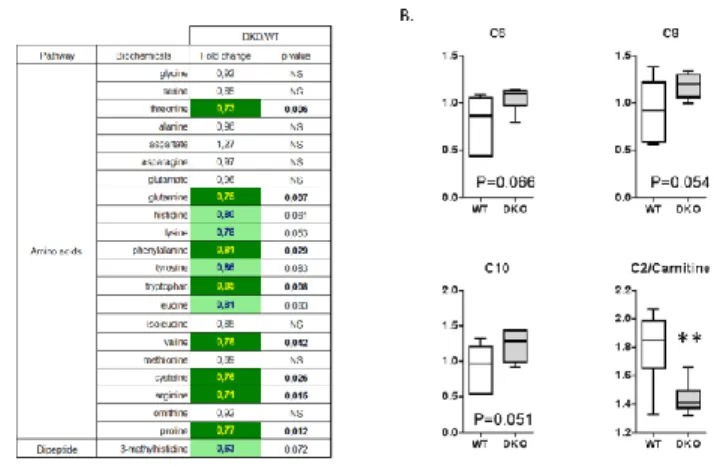HAL Id: hal-02735400
https://hal.inrae.fr/hal-02735400
Submitted on 2 Jun 2020
HAL is a multi-disciplinary open access
archive for the deposit and dissemination of
sci-entific research documents, whether they are
pub-lished or not. The documents may come from
teaching and research institutions in France or
abroad, or from public or private research centers.
L’archive ouverte pluridisciplinaire HAL, est
destinée au dépôt et à la diffusion de documents
scientifiques de niveau recherche, publiés ou non,
émanant des établissements d’enseignement et de
recherche français ou étrangers, des laboratoires
publics ou privés.
Distributed under a Creative Commons Attribution - NonCommercial - NoDerivatives| 4.0
International License
Genetic ablation of 4E-BP1 and 4E-BP2 is associated
with increased muscle mass, strength, protein synthesis,
and energy metabolism alterations in aged mice.
Olivier Le Bacquer, Kristell Combe, B Ingram, Lydie Combaret, Dominique
Dardevet, Christophe Montaurier, Jérôme Salles, Véronique Patrac,
Christophe Giraudet, Christelle Guillet, et al.
To cite this version:
Olivier Le Bacquer, Kristell Combe, B Ingram, Lydie Combaret, Dominique Dardevet, et al.. Genetic
ablation of 4E-BP1 and 4E-BP2 is associated with increased muscle mass, strength, protein
synthe-sis, and energy metabolism alterations in aged mice.. Benelux Metabolomic Days 2018, Sep 2018,
Rotterdam, Netherlands. 2018. �hal-02735400�
Genetic ablation of 4E-BP1 and 4E-BP2 is associated with increased muscle mass,
strength, protein synthesis, and energy metabolism alterations in aged mice.
Le Bacquer O
1, Combe K
1, Ingram B
3, Combaret L
1, Dardevet D
1, Montaurier C
1, Salles J
1, Patrac V
1,
Giraudet C
1, Guillet C
1, Sonenberg N
2, Boirie Y
1, Walrand S
11 Université Clermont Auvergne, INRA, Clermont-Ferrand, France 2 Dept. of BiochemistryMcGill University, Montréal, Canada
3 Metabolon Inc., Morrisville, NC, USA
E-mail: olivier.le-bacquer@inra.fr
1. Introduction
Sarcopenia is the loss of muscle mass/function that occurs during the aging process. The mammalian target of rapamycin (mTOR) is a multiprotein complex linking nutrient availability to cell growth and proliferation. It is a key player in the control of muscle development [1]. However, the key downstream targets of mTOR and their respective importance in controlling skeletal muscle function are still poorly understood. eIF4E-Binding proteins (4EBPs) are involved in the control of translation initiation by mTOR. Deletion of 4EBP1 and 4EBP2 in mice leads to increased sensitivity to diet-induced obesity, insulin resistance and ectopic accumulation of lipids, i.e. in skeletal muscle [2, 3]. Despite increased systemic insulin resistance DKO mice display an increased muscle mass in response to HFD [2]. On the other hand, transgenic overexpression of 4EBP1 protects mice against obesity [4, 5]. The aim of this study was to characterize the effect of 4EBP1 and 4EBP2 deletion on skeletal muscle function and homeostasis in aged-mice and to analyze the potential associated metabolic alterations by metabolomic and lipidomic profiling.
2. Approach
24-month old wild-type (WT) and whole body 4E-BP1/4E-BP2 double knock-out (DKO) mice were used to measured forearm grip strength and wire screen holding time (n=5-6). Weight of the hindlimb muscles was measured after sacrifice. Protein synthesis was measured ex-vivo in EDL by incorporation of L-[U-14C] Phenylalanine in the presence or
absence of leucine/insulin. Metabolomic and lipidomic profiling of skeletal muscle were performed by METABOLON, Inc. Differences between groups were analyzed with a Welch’s two-sample t-test. A p value of 0.05 was considered statistically significant
3. Results
4EBP1/2 DKO resulted in increased muscle mass and was associated with increased mean (100.0±6.1g vs. 66.6±4.8g, p<0.01) and maximal grip strength (128.9±8.5g vs. 95.2±11.7g, p=0.06). Protein synthesis was higher in
both basal (0.251±0.021nmol/mg prot/h vs.
0.124±0.021nmol/mg prot/h, p<0.05) and leucine/insulin stimulated conditions (0.313±0.011 nmol/mg prot/h vs. 0.189±0.053nmol/mg prot/h, p<0.05) in DKO skeletal muscle. Metabolomic and complex lipid analysis of WT and DKO skeletal muscle revealed robust differences pertaining
to amino acid homeostasis, carbohydrate abundance, and certain aspects of lipid metabolism. In particular, DKO skeletal muscle displays lower levels of most free amino acids (Fig.1A). Interestingly, although glucose level was unaltered, differences in the abundance of the compound maltitol/lactitol (p<0.01) and of several carbohydrate compounds were observed. 4EBP1/2 DKO also results in accumulation of medium-chain acylcarnitines and increased C2/C0 acylcarnitine ratio indicative of a reduced -oxidation (Fig.1B). Last, abundance of several N-acylethanolamines were significantly increased in DKO muscle (p<0.05).
Figure 1. A) Heat map of free amino acids fold change values between WT and DKO aged-muscle. B) Boxplots are shown for some medium-chain acylcarnitine and C2/C0 acylcarnitine ratio. **p<0.05 vs. WT.
4. Discussion
These results demonstrate that deletion of 4EBP protein is associated with perturbation of the energy metabolism in skeletal muscle and might have beneficial effects on skeletal muscle mass and function in aging mice. They also reveal a potential link between 4EBPs, muscle mass and endocannabinoid-like molecules.
References
[1] Bentzinger CF. et al. Cell metabolism 2008. [2] Le Bacquer O. et al. Journal of clinical investigation 2007. [3] Le Bacquer O. et al. Molecular nutrition & food research 2017 [4] Tsai S et al. The Journal of clinical investigation 2015. [5] Tsai Set al. Cell reports 2016.
